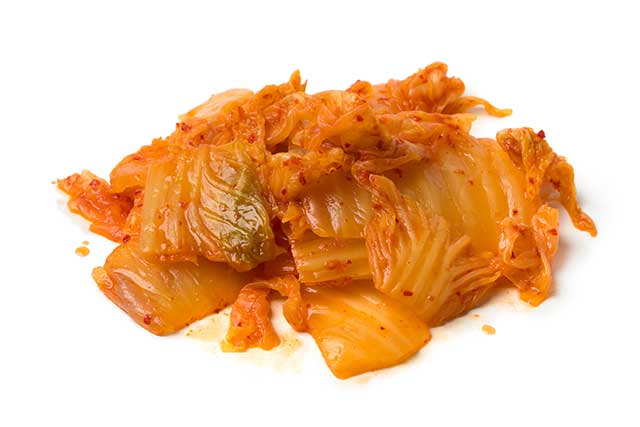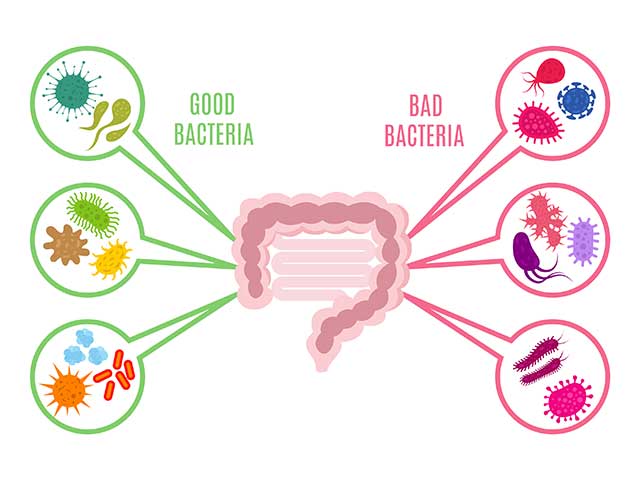Over the past decade, kimchi has taken the world by storm.
First appearing as exotic food, we can now find it on store shelves everywhere.
But just what is kimchi and what health benefits does it offer?
This article provides a guide to kimchi, its nutritional values, potential benefits, and more.
What Is Kimchi?

Kimchi is a mildly spicy fermented food originating from Korea.
In its homeland, people eat kimchi as a side dish/condiment, and it is a part of almost every meal.
Surprisingly, kimchi is so popular that most families have an extra refrigerator, creatively titled ‘kimchi refrigerator,’ just for storing a year’s supply of it.
Whether people love, like, or hate the taste, it is hard to argue with just how flavorful this spicy side dish is.
Kimchi tastes somewhat spicy, salty, and it has slightly sour and tangy notes.
It is not difficult to see why kimchi has such intense flavors when you look at all the ingredients it contains.
Typical Kimchi Ingredients
Kimchi is a fermented cabbage product.
Although it shares some resemblance to sauerkraut in this regard, kimchi contains a wide range of additional ingredients.
Typical cabbage kimchi will use the following ingredients;
- Napa cabbage
- Red pepper powder
- Daikon radish
- Green onions
- Garlic
- Ginger
- Fermented fish sauce
- Salt
After mixing all these ingredients, they are left to ferment for several months.
Other Types of Kimchi
Although cabbage is the most famous variety of kimchi, there are all kinds of different varieties, and all use different ingredients and recipes.
Some of these feature cucumbers or radish as the main ingredient.
Nutrition Facts
In the following section, we will examine the nutrition profile of kimchi per 100-gram serving.
The source of the nutritional data is the respected NCC Food and Nutrient Database.
| Calories/Nutrient | Amount |
|---|---|
| Calories | 19.6 kcal |
| Carbohydrate | 2.93 g |
| Fiber | 0.84 g |
| Sugars | 1.30 g |
| Fat | 0.36 g |
| Saturated Fat | 0.07 g |
| Monounsaturated Fat | 0.05 g |
| Polyunsaturated Fat | 0.16 g |
| Omega-3 Fatty Acids | 0.10 g |
| Omega-6 Fatty Acids | 0.06 g |
| Protein | 1.86 g |
Kimchi is very low in calories, and it is primarily a source of carbohydrate. It contains a small amount of fiber, fat, and protein.
| Vitamin | Amount | % DV |
|---|---|---|
| Vitamin C | 37.4 mg | 62.3 % |
| Vitamin K1 | 46.3 % | 46.3 % |
| Vitamin A | 125 mcg RAE | 13.9 % |
| Folate | 41.9 mcg | 10.5 % |
| Pyridoxine (B6) | 0.17 mg | 8.4 % |
| Niacin (B3) | 0.86 mg | 4.3 % |
| Riboflavin (B2) | 0.06 mg | 3.8 % |
| Thiamin (B1) | 0.04 mg | 2.3 % |
| Choline | 8.0 mg | 1.5 % |
| Pantothenic Acid (B5) | 0.10 mg | 1.0 % |
| Vitamin E | 0.15 mg | 0.7 % |
| Cobalamin | 0.03 mcg | 0.5 % |
| Mineral | Amount | % DV |
|---|---|---|
| Manganese | 0.15 mg | 7.3 % |
| Calcium | 72.4 mg | 7.2 % |
| Sodium | 169.88 mg | 7.1 % |
| Potassium | 212.66 mg | 6.1 % |
| Iron | 0.72 mg | 4.0 % |
| Phosphorus | 37.56 mg | 3.8 % |
| Magnesium | 14.55 mg | 3.6 % |
| Copper | 0.05 mg | 2.7 % |
| Zinc | 0.20 mg | 1.3 % |
| Selenium | 0.73 mcg | 1.0 % |
Health Benefits
Kimchi may have several health benefits related to its nutrient composition and the bioactive compounds it contains.
1) Kimchi Is High In Vitamin C and Vitamin K
Kimchi is an excellent source of vitamin C and vitamin K.
Vitamin C is a nutrient that plays a vital role in immune health and the growth and repair of skin, bones, and tissues (1).
Turning to vitamin K, this nutrient has some potential benefits for bone health and lowering the risk of cardiovascular disease (2).
However, it appears that vitamin K1 (found in kimchi) isn’t as bioavailable as vitamin K2 (3).
Vitamin K2 occurs in fatty animal products such as liver, cheese, and eggs, as well as fermented soy dishes such as natto (4).
In addition to these two vitamins, kimchi also provides a wide range of vitamins and minerals in smaller quantities.
2) Contains Probiotic Bacteria Species

As a fermented food, kimchi contains a significant amount of probiotic bacteria species.
The media often refer to these probiotics as “good bacteria.”
We can find many of these bacterial strains in kimchi, and they include (5);
- Leuconostoc mesenteroides
- Leuconostoc citreum
- Leuconostoc gasicomitatum
- Leuconostoc kimchii
- Leuconostoc inhae
- Weissella Koreensis
- Weissella cibaria
- Lactobacillus plantarum
- Lactobacillus sakei
- Lactobacillus delbrueckii
- Lactobacillus buchneri
- Lactobacillus brevis
- Lactobacillus fermentum
- Pediococcus acidilactici
- Pediococcus pentosaceus
Studies show that a higher intake of such probiotic strains can increase the number of beneficial bacteria in the gut (6).
Additionally, a higher ratio of “good” bacteria to “bad” in the gut appears to lower the risk of obesity and disease (7).
3) Higher Kimchi Consumption Is Associated With Lower Risk of Atopic Dermatitis
Atopic dermatitis is a type of skin condition that causes red and scaly rashes on the skin (8).
Inflammation is the root of this condition, and it can occur at any age, though it tends to be more common in children and young adults (9, 10).
Interestingly, population studies in Korea suggest there is a link between higher kimchi intake and reduced dermatitis risk (11, 12).
However, as with all epidemiological data, it is worth remembering that correlation does not necessarily equal causation.
4) A Source of Isothiocyanates
Due to its major ingredient—napa cabbage—kimchi provides a good source of isothiocyanates (13).
We can find these isothiocyanate compounds in cruciferous vegetables, and research suggests they may have health benefits.
On this note, most studies looking into isothiocyanates see them as having potential anti-cancer properties (14, 15).
For instance, cell (test tube) and animal studies demonstrate that isothiocyanates can inhibit the activation of carcinogens (16, 17, 18).
Since human trials are limited, this does not necessarily mean the same is true in humans, and research is ongoing.
5) A Rich Source of Polyphenols
Kimchi is full of herbs and spices such as garlic, ginger, and chili pepper, and these ingredients are some of the most concentrated polyphenol sources (19, 20, 21).
As a result, kimchi contains large amounts of these bioactive compounds.
Furthermore, in vitro (cell) studies show that kimchi has a protective effect against oxidative stress (22, 23).
Once again, studies taking place outside of the human body do not automatically infer the effect would be the same within the body.
That said, there is a large range of ongoing research on polyphenols, and they are thought to have benefits for human health (24, 25).
6) Kimchi May Lower Fasting Blood Glucose Levels
Some research suggests that kimchi may have a beneficial effect on fasting blood glucose levels.
In a randomized trial featuring twenty-two obese patients, four weeks of fermented kimchi consumption reduced fasting blood glucose levels. Furthermore, there was also a beneficial effect on blood pressure (26).
Further studies in rats showed that feeding the animals kimchi in their feed led to statistically significant lower fasting blood glucose levels compared to the control group (27).
However, these are only small trials, and larger human studies are necessary to prove these effects in humans better.
Potential Concerns and Side Effects
Although kimchi has several potential health benefits, there are also some concerns.
1) Very High In Sodium
Making kimchi requires a substantial amount of salt, and thus, it is very high in sodium.
For example, some commercial kimchi products may contain as much as 900 mg sodium per 100 grams. 900 mg of sodium is roughly equivalent to 2.3 grams of salt (28).
While there is nothing wrong with moderate amounts of salt in the diet, there are some people who suffer from a condition called ‘salt sensitivity’ (29).
In such individuals, too much dietary salt can have a significant impact on blood pressure levels (30).
For this reason, anyone with salt sensitivity or hypertension may wish to be conservative with their kimchi intake, or at least discuss it with their doctor.
2) Research Suggests High Kimchi Intake May Increase Gastric Cancer Risk
Perhaps the biggest concern about kimchi consumption is the research linking it with higher gastric cancer risk.
On this note, a systematic review and meta-analysis recently analyzed observational studies on pickled vegetable consumption in Korea, China, and Japan.
The review found that 30 studies showed that pickled vegetable intake significantly increased cancer gastric cancer, while only one study demonstrated a decreased risk (31).
A further systematic review presented how kimchi/pickled vegetables may increase the risk of gastric cancer, mainly when a stomach infection called Helicobacter pylori (H. pylori) is also present (32).
Furthermore, data released by the Asan Medical Center, Korea support these links.
Notably, this data shows that individuals with H. pylori infection and high salt intake have a tenfold higher risk of early gastric cancer (33).
Where To Buy Kimchi
In recent times, it is easy to find kimchi at any big grocery store or supermarket.
However, it may be worth checking a local Korean or Chinese mart for a greater variety of options.
Since kimchi can be expensive in the Western world, it is also worth considering making your own at home.
While homemade kimchi may be a little difficult the first time, it is relatively straightforward.
Tasty Kimchi Recipes To Try

Here are two great kimchi-related dishes.
If you ever visit a Korean restaurant, you will notice that kimchi is served with pretty much every dish.
However, it fits exceptionally well with pork-based dishes.
1) Kimchi Stew
Kimchi stew is a traditional Korean staple that combines kimchi, pork belly, and a variety of vegetables and seasonings.
With a spicy and flavorful taste accompanied by big pieces of fatty pork belly, vegetables, and sesame oil, this dish tastes delicious.
If you have some kimchi on hand, it is quite easy to make, and there is a great recipe here.
2) Grilled Kimchi With Pork Belly
Once again, kimchi and pork work so well together.
Anyone who has sampled Korean BBQ will likely have tried pork belly alongside pieces of kimchi.
Typically, people eat a piece of pork belly layered with kimchi wrapped inside a kind of lettuce leaf.
It’s definitely a tasty mix.
Final Thoughts
Kimchi is a tasty side dish that can also form part of a main meal.
This fermented dish offers a good number of beneficial nutrients, and it contains various compounds that may also promote good health.
The only downsides are the high sodium content for people who are salt sensitive, and the potential gastric cancer risk for people who consume significant amounts.
However, this risk appears to be strongly influenced by the presence of a stomach infection.
Overall, kimchi is a unique and flavorful food, and it offers some good nutritional benefits too.
For more on condiments, see this guide to mustard.

